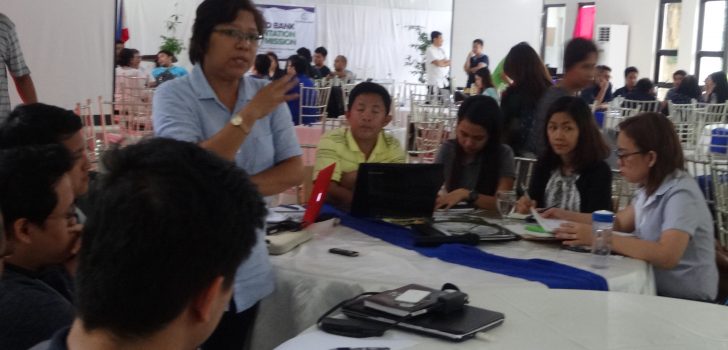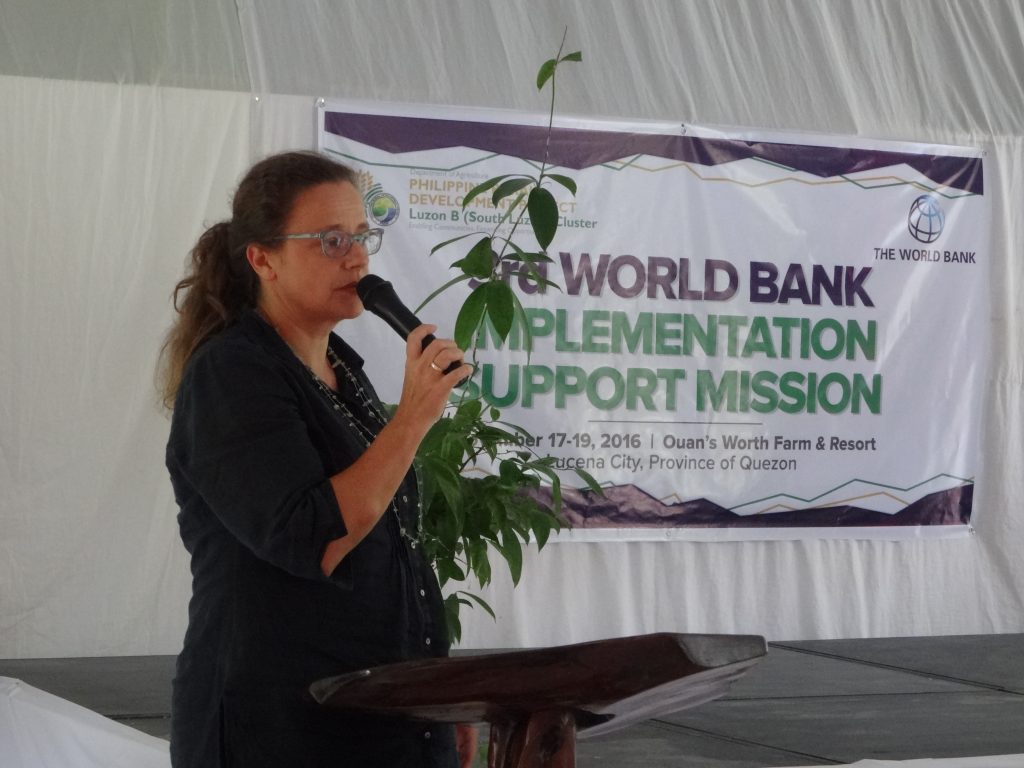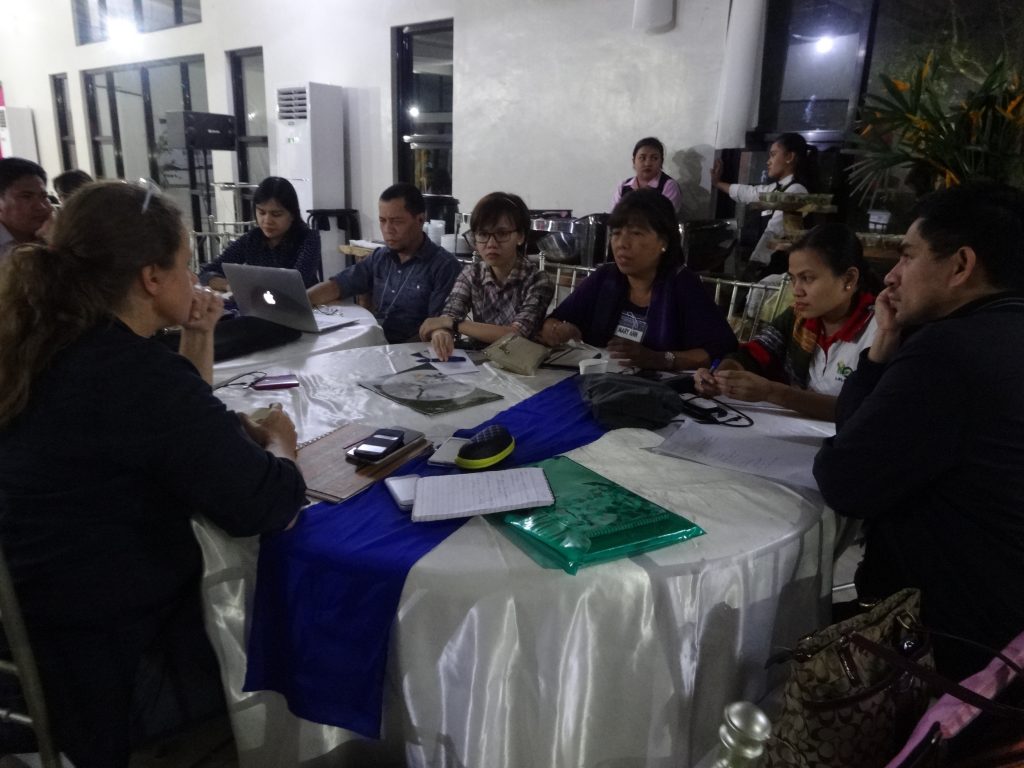 Economist Luningning Bondoc interacts with PRDP-South Luzon’s I-SUPPORT team to discuss their issues and concerns during the 3rd World Bank Implementation Support Mission held in Lucena City on November 17, 2016. (Photo by Annielyn L. Baleza, DA-PRDP RPCO V InfoACE Unit)
Economist Luningning Bondoc interacts with PRDP-South Luzon’s I-SUPPORT team to discuss their issues and concerns during the 3rd World Bank Implementation Support Mission held in Lucena City on November 17, 2016. (Photo by Annielyn L. Baleza, DA-PRDP RPCO V InfoACE Unit) PRDP-Bicol has biggest share in South Luzon’s VCAs, I-REAP project proposals
PRDP-South Luzon is on top of the leaderboard among clusters in terms of value chain analysis (VCA) approval. This was announced by Philippine Rural Development Project (PRDP) South Luzon Director Shandy M. Hubilla during the 3rd World Bank Implementation Support Mission held on November 17, 2016 in Lucena City. Of these, 83 percent is from Bicol with a total of 18 VCAs, 11 of which were already approved. VCA is one of the science-based tools being used by the PRDP to provide a snapshot of the industry from production to marketing.
These VCAs are now being translated into Provincial Commodity Investment Plans (PCIPs), a three-year rolling consensus plan between the Department of Agriculture and local government units (LGUs). As part of PRDP’s effort to advance reforms in government-led projects, PCIP is being positioned as a strategic plan for convergence. Hubilla noted that PRDP-Bicol has generated P1.5 billion on top of PRDP investments out of PCIPs.
“The LGUs were able to fund PCIP even beyond PRDP budget/funding. We have DA-BUB, DOST and DTI supporting their product value chain. Ultimately, this is what we really want from the start to do, that all our processes and projects with DA will be aligned to the PCIP,” he said.
Likewise, Hubilla reported that PRDP-Bicol’s enterprise development (I-REAP) component made the biggest contribution of 62 percent to the cluster’s I-REAP portfolio with a total of 17 sub-projects amounting to P45.98 million. Also highlighted were the significant impacts of PRDP-Bicol I-REAP sub-projects’ dry run operations. The Abaca Fiber Processing and Trading Enterprise, being managed by the Pinoy Lingap Damayan Multipurpose Cooperative in Virac, Catanduanes, for example, has generated a net income worth P1.18 million from January to October 2016.

Lead Agriculture Economist and World Bank Task Team Leader Frauke Jungbluth shares the objectives of the 3rd World Bank Implementation Support Mission to South Luzon Cluster. (Photo by Annielyn L. Baleza, DA-PRDP RPCO V InfoACE Unit)
Lead Agriculture Economist and World Bank Task Team Leader Frauke Jungbluth lauded PRDP-South Luzon for being the first cluster, so far, that provided updates about I-REAP implementation.
“I really like that approach on more I-REAP projects going forward; that you pay attention to these results and impacts of I-REAP that were more difficult to capture than I-BUILD in many ways,” she added.
Hubilla also discussed the feasibility results of the Village Level Coconut Water Processing Facility, which was pilot-tested in Bicol, in terms of number of nuts, initial investment cost, net income, price per bottle and benefits to farmers.

PRDP RPCO V Deputy Project Director and I-REAP Component Head Adelina A. Losa (2nd from right) and Business Development Officer Victoria Eugene S. Florece (1st from right) meet with World Bank Economist Hanane Ahmed (1st from left) during the 3rd World Bank Implementation Support Mission held in Lucena City on November 17, 2016.
Meanwhile, the region accounted 42 percent of the cluster’s I-BUILD sub-projects. PRDP-Bicol ranked next to Calabarzon’s P1.4 billion-worth portfolio with 18 approved I-BUILD sub-projects amounting to P1.35 billion.
Furthermore, Hubilla underscored the correlation between the region’s agricultural area, rural population and poverty incidence in the Project’s implementation.
“It’s not about equally distributing them (the P7 billion PRDP additional financing for I-BUILD). It’s about how we distribute them equitably),” he added.
With a total agricultural area of 891,955 hectares, Bicol has about 88.26 percent rural population with 41.60 percent living below poverty threshold. “In terms of poverty, those people residing in rural areas, who work in the agriculture and fishery sector are among the poorest,” Hubilla remarked.

Lead Agriculture Economist and World Bank Task Team Leader Frauke Jungbluth listens to RPCO V Planning Specialist Mary Ann Cuya’s updates regarding the progress of I-PLAN implementation in Bicol. (Photo by Annielyn L. Baleza, DA-PRDP RPCO V InfoACE Unit)
A team of experts from the World Bank headed by Jungbluth came to Lucena City for the third leg of the 3rd World Bank Implementation Support Mission to review the cluster’s achievements towards the attainment of the Project’s development objectives and evaluate progress since the last review mission.
PRDP is a six-year WB-assisted project being implemented by the Department of Agriculture, which is designed to improve the quality of life in the countryside by increasing farmers’ income and developing an inclusive, market-oriented and climate-resilient agri-fishery sector in targeted project areas nationwide. ### (Annielyn L. Baleza, DA-PRDP RPCO V InfoACE Unit)
